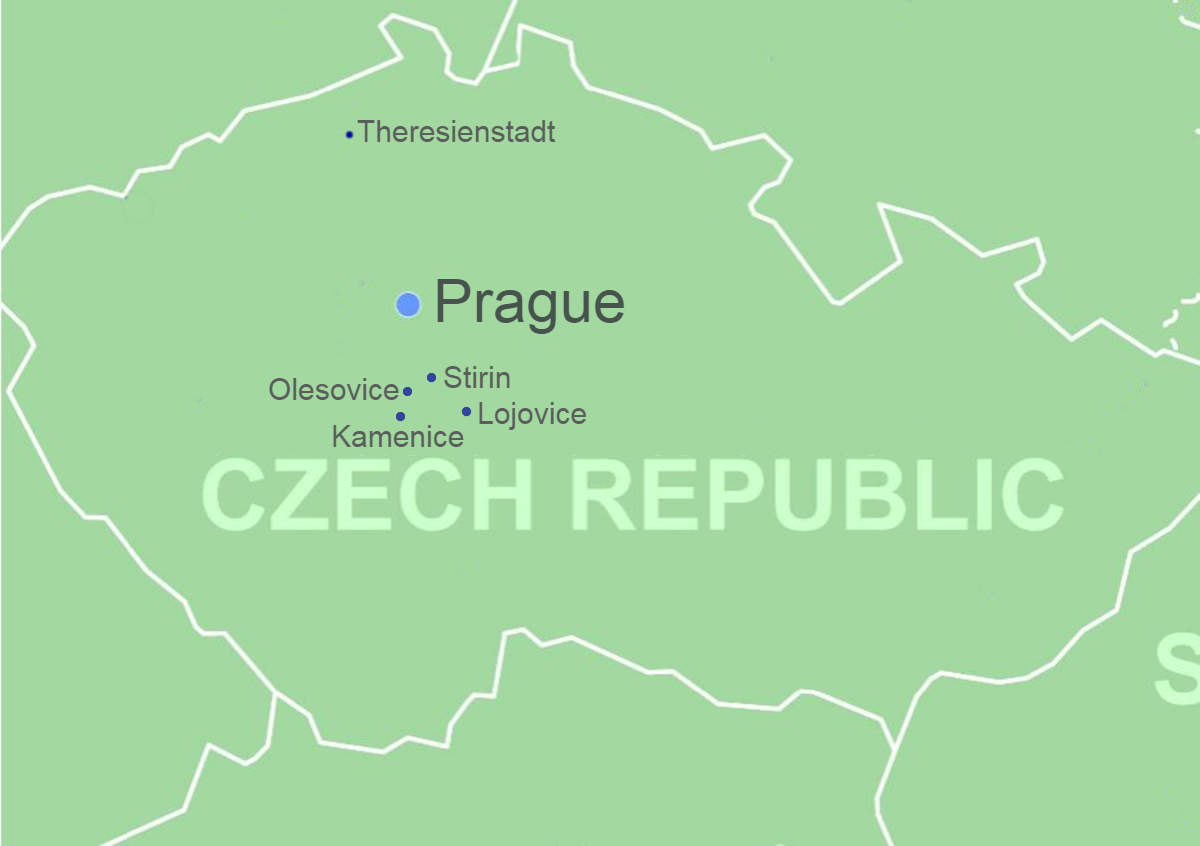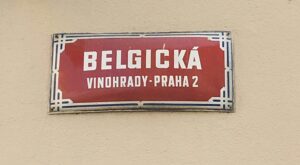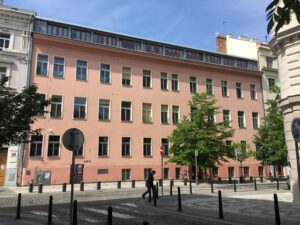Over 500 of the Boys passed at some point through the doors of the Home for Jewish Orphans on Belgicka Street in the Vinogrady district of Prague and the orphanage played a significant role in the majority of the Boys immediate post-war experiences.

Vinogrady was a centre of Jewish life in Prague and before the Second World War, it was home to the city’s largest synagogue, that was destroyed in a bombing raid. The nearby Belgicka orphanage was originally a home for Jewish orphaned boys and opened in 1898. Girls were cared for at another orphanage not far away. It was always intended to be an orphanage for Jewish children from all over the Austro-Hungarian Empire and Czech and German was spoken in the home so all the boys could make themselves understood.
Wartime
After the Nazi invasion more and more children crowded into the orphanage on Belgicka Street, which was also a hub for the now illegal education of Jewish children. In 1940 the girl’s orphanage moved to Belgicka Street. The Nazis closed the orphanage in 1943 and it was then used by the German security services. During the occupation, 429 children from the orphanage were deported as part of 40 different transports. Only 63 of them returned after the liberation.
It was at the orphanage that the children’s opera Brundibar or The Bumblebee was first performed in German occupied Prague before the mass transportations of the Bohemian and Moravian Jews to the Theresienstadt ghetto.
The score was smuggled into the camp where it was staged in the Magdeburg barracks in September 1943. It was a performance that some of the younger members of the Boys, who spent years in Thereseinstadt, may well have seen. The opera became a symbol of hope in Theresienstadt.
The Violinist
After the liberation, the orphanage was returned to the Jewish community and reopened in June 1945.
Halm Frantisek, the former lead violinist in the Prague Philharmonic Orchestra, was put in charge. He was at this point in his late 50s and wore thick rimmed glasses. He would entertain the children by playing the violin. One future member of the Boys, David Herman spent the first Yom Kippur after the liberation at the orphanage and remembered how Frantisek had “played one melancholic piece of music that made my lost childhood come rushing back to me. It was from the Kol Nidre service, and one of the most recognisable and holy songs of the Jewish faith.” Herman’s father had sung it to his children. “When Helm Frantisek played this sad, slow and soulful tune, it brought back overwhelming images from my childhood,” he recalled. “Halm Frantisek’s baleful violin was humbling to listen to and left me in floods of tears as painful memories of my family and our life together back home flashed through my mind.”
The young survivors slept six to a room and the orphanage had a capacity for about 70 children. Before the departure of the first group of the Boys, when over 200 of the Boys stayed here, camp beds were put up in the school rooms. The orphanage had a large dining room with several long tables, a number of kitchens and a library.
Education played an important role in the rehabilitation of survivors, as it was crucial to help the young people to stand on their own feet and to return to a normal life. From the end of war until 1950, 637 youngsters lived in the orphanage.
After the orphanage closed it was nationalised and only handed back to the Jewish community after the fall of communism. Today, the Belgicka orphanage is the Jewish community’s Lauder school.
Associated Boys:
- Bergermann, Moniek
- Bergmann, Hersch
- Berliner, Szyja
- Bernholz, Sala
- Binenstock, Benek
- Blumsztajn, Fishel
- Bomstyk, Majer
- Borgenicht, David
- Brand, Hersch
- Brauner, Chiel
- Braunheim, Solomon
- Breitburg, Solomon
- Bucci, Andra
- Bucci, Liliana
- Buki, Moniek
- Cederbaum, Joseph
- Cwajgenbaum, Szlamek
- Denderowicz, David
- Dicter, Avrom
- Dobrowolska, Masza
- Dresner, Samuel
- Dzialowski, Fajwel
- Elkienbaum, Abraham
- Englard, Benek
- Erreich, Abraham
- Erreich, Salomon
- Etkind, Moses
- Fajngcesycht, Jacob
- Falinower, Salek
- Ferstendig, Issac
- Fersztand, Jakob
- Finkelstein, Sevek
- Fishelberg, Chiel
- Fisz, Jurek
- Frajkorn, Mendel
- Freiman, Sam
- Friedman, Hedi
- Frydenberg, Berek
- Frydenberg, Laib
- Frydman, Nachman
- Frydman, Gershon
- Fuks, Jonah
- Fuks, Chaim
- Glicksohn, Jacob
- Goldberg, Szmul
- Goldberger, Jan
- Goldceckier, Hersch
- Golde, Heniek
- Goldstein, Abraham
- Grabia, Abraham
- Gross, Franja
- Grossman, Pinkus
- Gruen, Hugo
- Grynbaum, Gritta
- Grzmot, Motek
- Gutter, Pinchas
- Halter, Roman
- Hamburger, Julius
- Hausman, Rela
- Helgfott, Beniek
- Herman, David
- Herschlikowicz, Mayer
- Herszkowicz, David
- Herszlikowicz, Arek
- Hilf, Chaim
- Himmelfarb, Wolf
- Hirschfeld, Moniek
- Hirschfeld, David
- Hochman, Martin
- Hochspiegel, Sala
- Holckiener, Samuel
- Hubermann, Abraham
- Jacobowicz, Isek
- Jakubovicz, Rela
- Jakubowic, Armand Otto
- Jonisz, David
- Judenschneider, Szlama
- Judkiewicz, Chaim
- Kalmowicz, Simon
- Kaminski, Motek
- Kamionka, Motek
- Kandelcukier, Kopel
- Kirszberg, Abraham
- Klajnman, Chemia
- Klin, Simon
- Klotz, Marcus
- Kochen, Majer
- Kohn, Chaim
- Kohn, Josef
- Korman, Bluma
- Korman, Chaim
- Kornfeld, Bernard
- Koziwoda, Moniek
- Krowicki, Jacob
- Kura, Jacob
- Kurnedz, Pinkas
- Kurtz, Jan
- Kuszer, Binem
- Kuszerman, Szlama
- Kutner, David
- Kutner, Isek
- Laskier, Schmul
- Lecker, Simon
- Lewenstein, Motek
- Lewkowicz, Mordka
- Lewkowicz, Perez
- Licht, Israel
- Lichtenberg, Samuel
- Liebermann, Simche
- Loeffelholz, Salomon
- Malinicky, Moses
- Markowiecki, Schmul
- Melzer, Jacob
- Mlynarski, Hersh
- Moncarz, Jacob
- Munter, Minia
- Neumark, Joseph
- Neustaedter, Benek
- Nurtman, Bronek
- Nurtman, Moshe
- Obuchowski, Berek
- Olmer, Chaim
- Orenstein, Salek
- Orzech, Chaskiel
- Orzech, Shlomoh Reuven
- Pantoffelmacher, Salomon
- Perlmutter, Mayer
- Pomerance, Issac
- Popiel, Szaja
- Poznanski, Artek
- Poznanski, Jerzy
- Pretter, Mendel
- Przenda, Jurek
- Rajzman, Alexander
- Rajzman, Yitzhak
- Ratz, Joseph
- Rayber, Baruch
- Reichkind, Moshe
- Richter, Leiser
- Rosenberg, Moshe
- Rosenblat, Herman
- Rosenblatt, Zelig
- Rosenblum, Chaskiel
- Rosengarten, Samuel
- Rosenman, Roma
- Rosenweig, Naftali
- Rudzinski, Isroel
- Ruzagara, Henrik
- Salomon, Abraham
- Schindler, Alfred
- Schindler, Max
- Schnitzor, Josef Rafael
- Schoenberger, Elias
- Schottland, Moniek
- Schulsinger, Abraham
- Schwimmer, Zisha
- Schwitzer, Bella
- Senkpiel, Gisela
- Silberstein, Mendel
- Sommer, David
- Sosnowicz, Meir
- Spiro, Chaim
- Szajnzicht, Moniek
- Szajnzicht, Cesia
- Szlamberg, Chaim
- Szternfeld, Mietek
- Szurek, Dan
- Tabacznik, Motek
- Tarko, Joine
- Teichmann, Mendel
- Tenenbaum, Zelik
- Tepper, Leopold
- Traub, Hanka
- Traub, Eva
- Tuch, Moritz
- Turek, Rosa
- Turek, David
- Wagshal, Leib
- Wajchendler, Chaim
- Wajchendler, Herschel
- Waksztok, Menachem
- Warsznitzer, Hersch
- Wasserzeicher, Adolf
- Wegner, Harry
- Weiner, Abraham
- Wertman, Abraham
- Wiernik, David
- Wilder, Israel
- Winogrodzki, Rafael
- Wolkowicz, Stephen
- Wolreich, Abraham
- Zaks, Henryk
- Zaks, Simon
- Zamel, Hirsch
- Zylberszac, Aron
- Zyskind, Hersch

